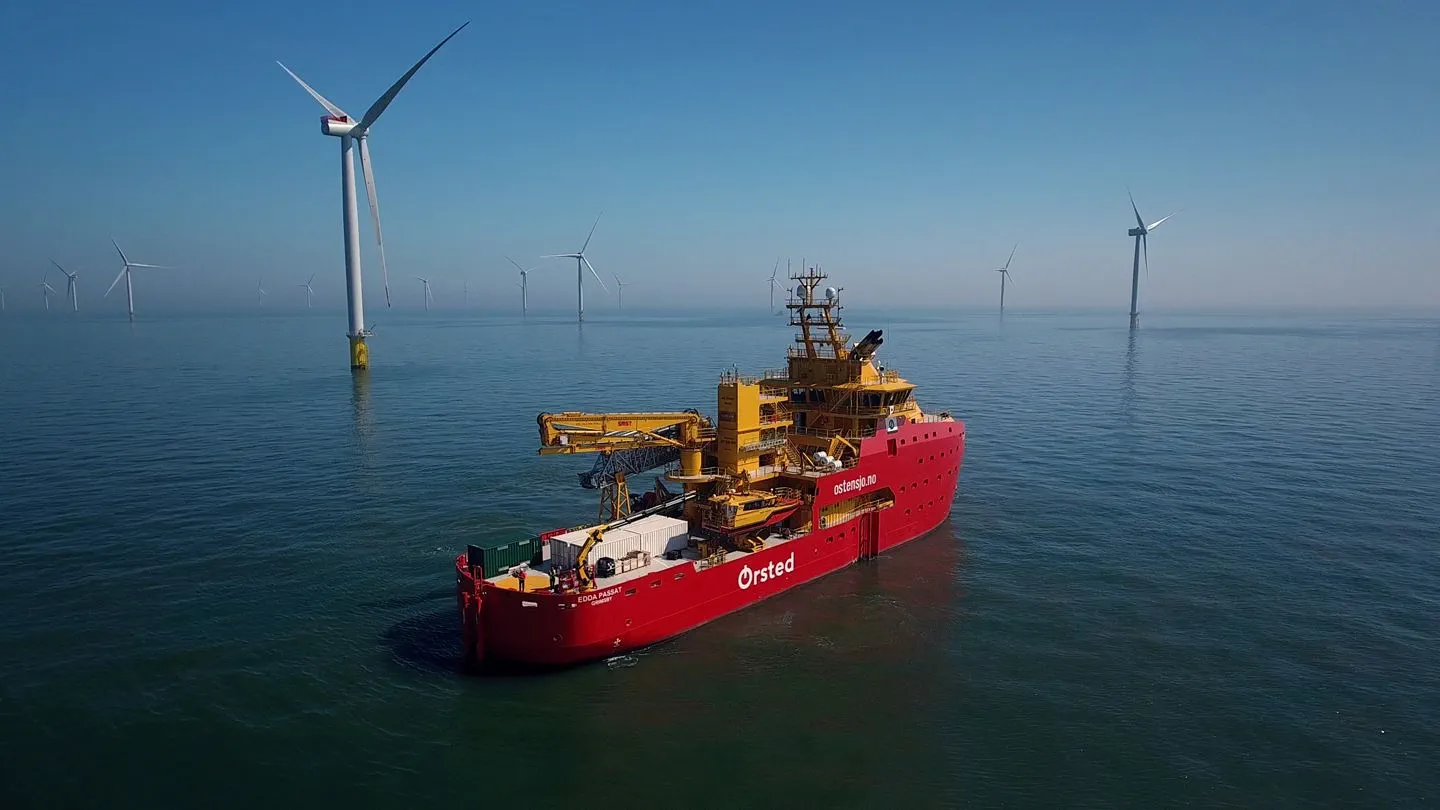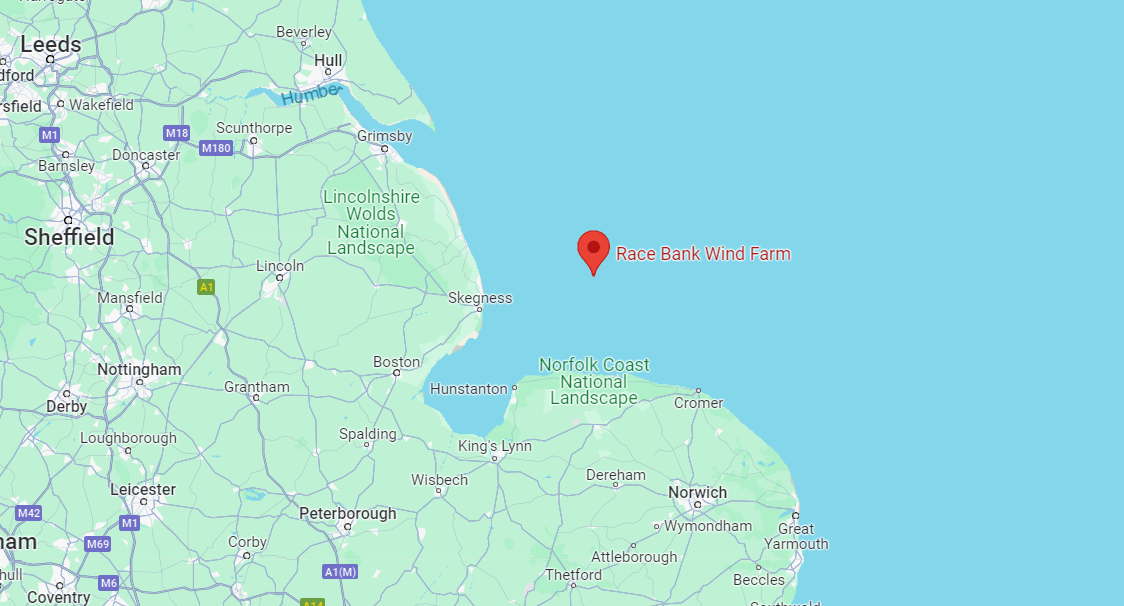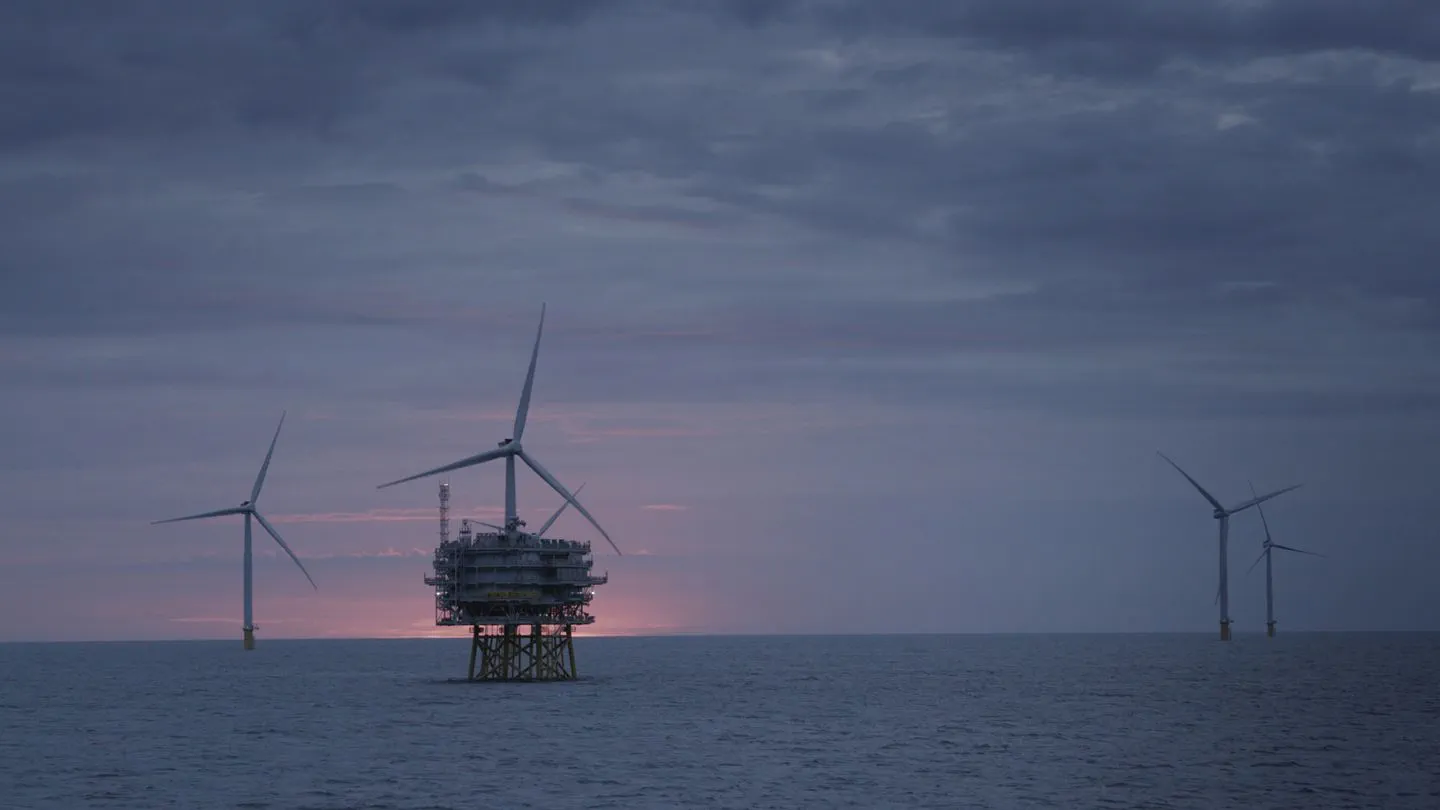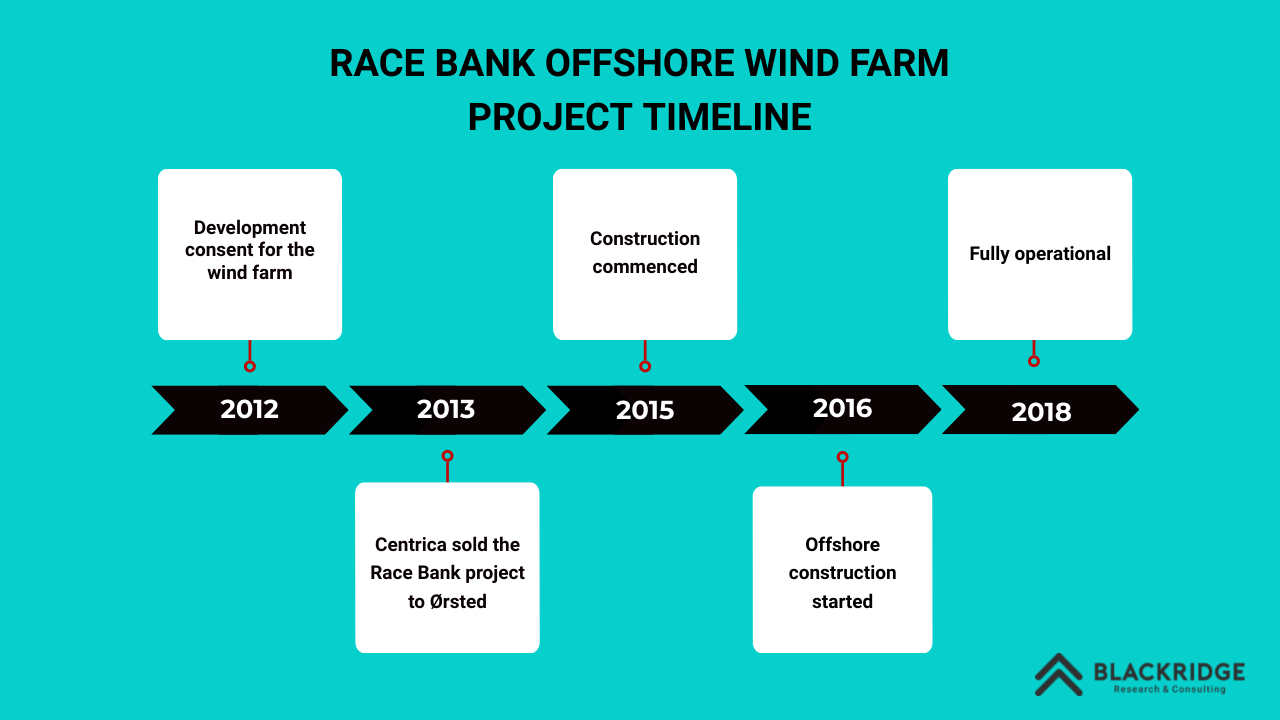Table of Contents
| Project at a Glance | |
| Project Name | Race Bank Offshore Wind Farm |
| Project Type | Greenfield |
| Project Location | UK east coast in the North Sea |
| Sector | Energy |
| Subsector | Wind Energy |
| Project Value | GBP 3.2 Billion (USD 3.3 Billion) |
| Project Status | Commissioned |
| Project Developer/Coordinator | Ørsted |
| Capacity | 573.3 MW |
| Construction Start Date | 2016 |
| Project Completion Date | 2018 |
Overview
The Race Bank Offshore Wind Farm is a greenfield project located off the east coast of the UK in the North Sea. This offshore wind farm developed by Ørsted is considered one of the landmark projects in the UK wind power market. The construction of the project started in 2016 and was fully commissioned later in 2018.

The offshore wind project has a capacity of 573.3 MW, powering approximately 500,000 households in the UK. This will contribute to the goal of achieving between 30% and 45% of the UK's energy consumption from renewable sources by 2030. Also, Race Bank Offshore Wind Farm offsets around 830,000 tonnes of CO2 annually.
The project features wind turbines installed on fixed monopile foundations. The leading developer, Ørsted, holds a 50% ownership stake in the project. The remaining stakes are owned by Macquarie European Infrastructure Fund 5 (25%), Sumitomo Corporation (12.5%), Arjun Infrastructure Partners (6.25%), and Gravis Capital Management (6.25%).
Project Background
The development of the Race Bank Offshore Wind Farm started in 2004 when the Crown Estate awarded a 50-year lease to Centrica. The UK’s Department of Energy and Climate Change granted development consent for the project in 2012, setting the course for the construction of the project.
Ørsted's involvement in the project started in 2013 when Centrica sold the Race Bank project to Ørsted (then known as DONG Energy) for GBP 50 million. Construction officially commenced in 2015, and onshore work started in the same year. The offshore construction of the wind was started in 2016.
Find Offshore Wind Project and Tender Leads in UK Claim Your Free Leads Now!
After the installation of the wind turbines in May 2017, the wind farm became fully operational by February 2018. It is operated and maintained from the East Coast Hub in Grimsby. This boosted the local economy by employing a workforce of more than 300 people.
Diamond Transmission Partners acquired the transmission assets of the Race Bank wind farm for GBP 472.5 million in 2019. This sale included the onshore and offshore substations as well as the export cables. The wind farm has an estimated operational lifespan of 25 years and is a greater contributor to the UK's green energy transition in recent years.
Project Location Details

The Race Bank Offshore Wind Farm is located about 27 km off Blakeney Point, on the north Norfolk coast. The water depths at the site range from 4 meters to 22 meters. The wind farm covers an area of 75 km² in the North Sea and is positioned about 28 km east of Chapel St. Leonards, off the Lincolnshire coast.
The export cable makes landfall in the Greater Wash with the onshore substation. This connects the offshore power to the national grid, located near Walpole.
The installation base for the project includes several ports like Antwerp in Belgium, Hull in the UK, and Szczecin in Poland. The operations and maintenance (O&M) of the wind farm are managed from Grimsby, UK.
Technical Specifications
The Race Bank Offshore Wind Farm is equipped with 91 Siemens SWT-6.0-154 wind turbines each mounted on monopile foundations. These turbines feature a rotor diameter of 154 meters and have a power-generating capacity of 6.3 MW. The Race Bank wind farm project became the first to implement the 177 meters tall Siemens 6.0 MW platform.
The wind turbines are interconnected through an array cable network that links them to two offshore substations. These substations are strategically positioned to ensure efficient energy transmission and operational reliability. The northern offshore substation is connected to the turbine network via eight feeder circuits, while the southern offshore substation is connected through nine feeder circuits.
The offshore substations have identical design with 35 meters high topside structure weighing 2,900 tonnes. The supporting piles and jackets for the substations weigh an additional 2,600 tonnes. These substations are critical for converting and transporting the generated power to the onshore substation near Walpole.

The renewable energy is transmitted through two 220 kV subsea export cables. The two cables are interconnected, a design that mitigates risks and enhances operational availability.
The overall route for power transmission spans nearly 83 km. This includes 71 km of subsea cable from the offshore substations to the onshore transition joints and an additional 11.6 km of onshore export cables from these transition joints to the onshore substation. The onshore substation then transmits the electricity into the national grid.
The Transmission Entry Capacity (TEC) at the Offshore Transmission Owner (OFTO) interface point is 565 MW, and the capacity exported at the onshore boundary point is 548 MW. The difference between the installed and connected capacity is due to losses incurred through the wind turbine generator (WTG) transformers and the array cables.
Contractors Involved
| Contractor | Role |
| Royal HaskoningDHV | Environmental assessments |
| RPS | Planning and environmental consultancy |
| ABPmer | Seabed Mobility Assessment |
| APEM | High-resolution aerial wildlife surveys |
| Siemens Gamesa | Wind turbine supply |
| Eiffage Smulders | Offshore substation topsides and jackets |
| Vercity | Management Service Agreement (MSA) |
| RXHK | STATCOM systems |
| Murphy | Onshore cable installation |
| DeepOcean | Array cable installation |
| JDR | Inter-array cable supply |
| Firemac | Protective-screened enclosures |
| Nimmo Industrial Buildings | Installation of protective enclosures |
| CallMac Scaffolding | Offshore access to wind turbines |
| Jan De Nul Group | Cable installation between the wind farm and the mainland |
Subscribe Blackridge Research's UK offshore wind farm database for more details on contractors
Project Benefits
The Race Bank Offshore Wind Farm has brought economic and social benefits to the local area, same as Lynn and Inner Dowsing wind farms. The project boosted the local economy by employing local vessels for survey work during construction. In the long term, the wind farm continues to create jobs by employing operations and maintenance (O&M) staff, contributing to regional community development.
Project cost
The estimated project cost of the Race Bank offshore wind farm is GBP 3.2 Billion (USD 3.3 Billion).
In 2016 Ørsted (formerly DONG Energy) entered into an agreement to sell 50% of Race Bank. The total transaction proceeds consist of the acquisition of a 50% ownership share and commitment to fund 50% of the project CAPEX. This, including transmission assets, amount to approximately GBP 1.6 billion.
Project Timeline

Current and Future Outlook
In June 2024, Macquarie Asset Management and Spring Infrastructure Capital 1 Investment Limited Partnership agreed to sell a 37.5% stake in the Race Bank wind farm. Norges Bank Investment Management will pay GBP 330 million (USD 418 million).
Ørsted UK proposed a Race Bank Extension project located adjacent to the existing wind farm. The project is still in the early stages of development. Race Bank Extension could generate another 573 MW of green electricity.
Conclusion
The Race Bank Offshore Wind Farm is an achievement in the UK's renewable energy sector and offshore wind industry. Started operation in 2018, this 573.3 MW capacity wind farm is an example for advancement of offshore wind technology and its growing role in the UK's energy mix. The project compliments the carbon reduction initiatives of the UK by powering approximately 500,000 UK households and offsetting around 830,000 tonnes of CO2 annually.
Race Bank was the first to implement Siemens' 6.0 MW wind turbine platform, a milestone in the industry's move toward larger and more efficient turbines. Its successful implementation, ongoing operation, and potential for expansion underscore the vital role of offshore wind in the UK's energy transition and efforts to combat climate change.
Connect with decision-makers of offshore wind projects in the UK for business opportunities.
Subscribe to our offshore wind projects database in the UK and receive exclusive benefits like
- Regular updates on offshore projects and tenders
- In-progress and Completed offshore wind projects
- Essential details, Timely Updates, Key Stakeholder Contact Information
- Industry Trends and insights by experts
Start a free demo to find the latest offshore wind farm projects in the United kingdom (UK) to take your business to the next level!







Leave a Comment
We love hearing from our readers and value your feedback. If you have any questions or comments about our content, feel free to leave a comment below.
We read every comment and do our best to respond to them all.